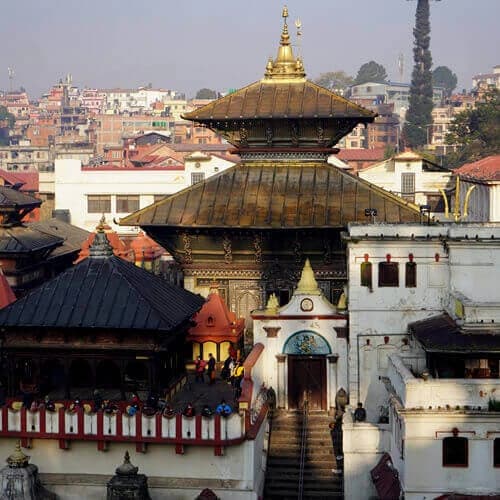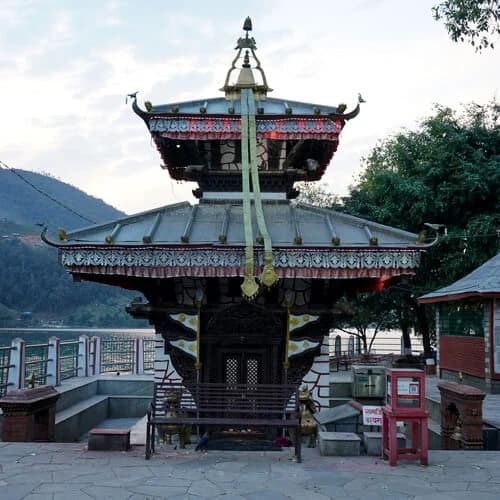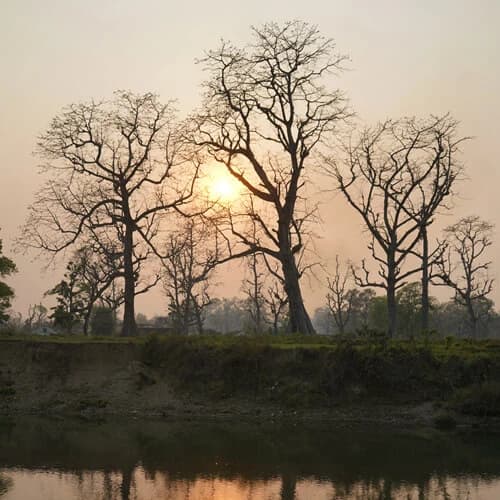Best Seasons for Island Peak Climbing
When each trekking season has its benefits, sticking to the peak season gives you a lot more than the off-season. Hence, the best seasons to climb Island Peak are spring and autumn. These seasons not only provide the best environment to trek and climb but also make your journey easier with favorable weather conditions. So, don’t wait and book the island peak climbing in Spring and Autumn with us.
Island Peak Climbing in Spring
The spring season, comprising March, April, and May, is excellent for climbing Island Peak because it has the least amount of precipitation and the gentlest weather. The weather is beautiful at this time of year, with mild temperatures and bright, sunny days. The typical daytime temperature in spring is 15 to 17 degrees Celsius, with nighttime temperatures as low as -8 degrees Celsius.
At the start of the season, there's a blast of cool air accompanied by a light snowfall. As time passes, things improve. By the end of March, the winter's lingering effects will have faded, and visitors will be able to enjoy brilliant sunny days once more. During the spring, travelers are less likely to notice a drastic change in the weather. The weather is often cold at the start of the season, but by the end of spring, the temperature has risen substantially.
Island Peak Expedition in March
March is an excellent month to visit the mountains. It features pleasant weather, peaceful routes, and beautiful scenery. The courses are less crowded in the month due to the post-winter temperature. In the first couple of weeks of the month, the Island peak is bitterly chilly.
Only at the end of the month is the climber able to enjoy the weather. From here on out, the weather becomes more consistent, with temperatures reaching highs of 15 degrees Celsius. Following the lowest temperature of -15 degrees Celsius, the nights are cooler and more humid across the region.
Mornings are bright and sunny, while afternoons are cold and windy. In the evenings, the weather in Island Peak is frequently frigid, with temperatures ranging from -7 to -14 degrees Celsius. The trekkers might even encounter snowstorms throughout the night, so they should carefully plan for the journey.
Island Peak Expedition in April
April is the mid-spring month. The weather changes swiftly at the Island Peak in April. It gets much warmer and sunny in April than in March. Beautiful mornings with a nice breeze and bright sunshine tend to enhance tourists' days.
Spring days in April are mostly sunny, with temperatures gradually rising. Mornings and evenings are cool, although not as cold as in March. The weather at Island Peak is pleasant during the day, with temperatures ranging from 0 to 17 degrees Celsius.
In April, the pleasant weather makes trekking simpler for climbers. It gets warmer at the end of the month than at the beginning. As the season progresses, the trail will get more crowded, and visitors may not have the entire trail to themselves. On the plus side, the month also brings pleasant weather with bright sunshine all day. April ensures that the cold winter days are long gone, allowing climbers to enjoy cool and pleasant weather.
Climbing Island Peak's icy ridge and glacier in April becomes surprisingly less challenging. Trekkers won't get frostbite or freeze their skin because the trails aren't completely covered in snow. You can easily reach the summit with the help of a trek leader and a few technical skills.
Island Peak Climbing in May
The temperature in May is slightly hotter than in the previous months. The temperature rapidly rises, reaching up to 20 degrees Celsius and higher. The temperature is warmer at lower elevations, although it is still below 0 degrees Celsius at the summit.
The weather is mild and pleasant at the beginning of the month. The temperature becomes increasingly heated as the month progresses toward summer. As the month progresses, the days become warmer, but tourists should not expect full-fledged summer weather.
With temperatures progressively rising, the humidity level is quite high this month. The weather appears to be balanced and normal for the most part, with warm mornings and slightly crisp evenings. The temperature fluctuations in high terrains are easy to notice, especially when frigid nights are replaced by warm air.
In comparison to other spring months, trekking the Island peak in May is less difficult that’s why it attracts lots of trekkers and climbers. The weather is pleasant this time of year, so climbers won't have to push themselves to reach the summit. You must, however, devote sufficient time to training and maintaining physical fitness.
Island Peak Climbing in Autumn
Autumn months in Nepal comprise September, October, and November. It is the best time to climb the peak in autumn when the weather is at its most delightful. During the season, it is neither blistering hot nor freezing cold. Autumn hikers have an easier time negotiating the trail because there are fewer barriers.
Climbing Island Peak in the autumn provides trekkers with an unforgettable experience and breathtaking vistas. The journey is made more interesting by the cold breeze and the brilliant fall foliage in the background, as well as the sound of birds chirping. It's also the best time to enjoy the views of Mt. Everest, Nuptse, Ama Dablam, Thamserku, and other lofty snow peaks. You can witness sheer glaciers, huge natural vistas, and vibrant valleys from afar.
Autumn is a fantastic season to visit the Everest region and navigate the trek while taking in the breathtaking scenery. The season clears the skies for hikers after the burning heat of summer and heavy rain. In autumn, there is no danger of landslides, floods, snowstorms, blizzards, or any other unforeseen disaster. Snow-capped mountains, vivid forests, brilliant valleys, and magnificent landforms are all part of the season's magnificent scenery.
Island Peak Climbing in September
Autumn officially begins in Nepal in September, though it arrives a little earlier in the Himalayas. This may be why there are fewer people at the beginning of the month. However, as time passes, the trail fills up with tourists, enjoying the pleasant weather while attempting to reach the summit.
In September, the temperature drops, but tourists can still feel the warmth in the air. The lower hills have a summery feel to them, but the upper elevations are still cold and windy. Trekkers can enjoy a beautiful vista with nearby hills and mountains in the frame as the fall foliage begins to creep in.
Temperatures range from 0 to 15 degrees Celsius on average, with the nights being frigid. However, as the days are bright and sunny, you'll get a few sightings of Ama Dablam and Makalu. Trekkers may be soaked in the rain at times, especially in early September. Thus, even during September, they'll have to be cautious while climbing Island Peak.
Island Peak Expedition in October
Climbers are encouraged to climb Island Peak in October because of the most favorable weather. The weather is kind to hikers and even makes it possible for them to reach the peak without difficulty. The days are bright and sunny, boosting visibility, while the nights and mornings are cool and breezy. As a result, Island Peak Climbing in October is spectacular, and there are fewer difficulties.
Autumn is in full bloom in October, with vibrant colors such as orange and crimson tinting the leaves. The leaves begin to fall on the trail as the months progress, making the woodland even more beautiful. During their trek, hikers come across wild species such as musk deer and Himalayan Tahr. Large numbers of trekkers make the paths and teahouses significantly noisier in October.
similarly, the itinerary is jam-packed with cultural and religious activities during this month. In October, visitors trekking the mountain can join the residents in their celebrations and festivities like Dashain and Tihar. You will be able to gain an understanding of the region's rich and diverse culture.
Island Peak Climbing in November
November is the end of the autumn season, therefore the weather is a little gloomy and drab. Although it is not as warm and cozy as October, climbers can still enjoy the sunshine during the day. From the beginning of the month, the weather begins to cool, but substantial snowfall is doubtful.
The weather in November is still unpredictable and trekkers should stay up to date on the weather prediction to avoid any unpleasant surprises. After the sun sets, it gets chilly, although the days are still warm, with temperatures reaching 12 degrees Celsius.
After the mid-season, the foliage on the trees begins to fade, so the vistas may not be as beautiful as they were in October. You can still take in the breathtaking views of snow-capped mountains such as Ama Dablam and Thamserku. Due to the overcast weather, you may have some difficulty catching a glimpse of Mt. Everest.
Late autumn can be bitterly chilly, and towards the end of the month, trekkers should expect a thin dusting of snow. The temperature on the peak might plummet below -10 degrees Celsius, and powerful winds can make mountaineers' lives harder. It's time to bundle up in thick clothing because the weather can be chilly at times, especially at higher elevations. Crampons will come in handy when exploring the glacier trails.
Foods on Short Island Peak Climbing
Exploring the Himalayan region of Nepal is an adventurous experience of a lifetime. You will trek for multiple days in high-altitude regions of Nepal and need a proper diet and hygienic food to keep you replenished and energized. The proteins and carbohydrates you intake during the expedition help maintain your fitness level for the trek. To provide you with a brief outlook on what the menu looks like on the trek, we have listed some of the common items provided in the teahouses.
- Breakfast options: Tibetan Bread, Chappati, Oatmeal, French Toast, Cornflakes, Mashed Brown, Eggs, Pancakes, Möseli, Porridge with Milk, and Möseli.
- Lunch options: thukpa, Dahl and Bhat, Momos, Tibetan / chapatti bread, spaghetti, marmalade, sherpa stew, soups, steaks, sandwiches, spring rolls, pizza, burgers, and rice with curry.
- Dinner options: momos, Thukpa, Dahl and bhat, Tibetan / chapatti bread, spaghetti, marmalade, sherpa stew, potato items, Raman soups, burgers, and pizza.
- Hot drink options: black and milk coffees, mint, ginger, green teas, lemon teas, mango juice, pineapple juice, and orange juice.
Accommodation facts
Accommodation establishments in the mountain regions of Nepal are very simple but sophisticated. The rooms are usually available on a twin-sharing basis and feature warm blankets, comfortable mattresses, pillows, and attached bathrooms. Please remember that the attached bathrooms are only available in some teahouses for an additional charge.
Note: Kathmandu has a range of luxury-star hotels from which you can choose. Upon your request, we will be pleased to arrange to reserve a four- or five-star hotel for you.
Passport and Visa
You will need a visa to enter Nepal, which you can get on arrival at the Tribhuvan International Airport, Kathmandu. You must have a passport that is valid for at least six months from the date the visa was issued. The number of stays is a counter from the day you enter the country. The Visa application fee is USD 40 for 30 days to foreigners, except Indian and Chinese citizens. Travelers from India and China won't need a visa to travel to Nepal.
Travel Insurance
Travel insurance is mandatory for travelers who want to trek in Nepal's high-altitude mountain regions. Having travel insurance with you during the expedition will significantly increase your safety and security, allowing you to enjoy the excursion without any worries or hassle. We suggest you get one from a reputed company that covers medical evacuation and helicopter rescue expenses. Further, please ensure that the travel insurance covers personal injury, illness, and repatriation expenses. You must provide a copy of the travel insurance before you begin the exciting journey with us. This will allow us to act swiftly if any unforeseen circumstances occur.
Gears and Equipment
It would help if you kept your luggage as light as possible to lighten the physical burden on you. Only bring the gear and equipment that are needed for the expedition. Also, pack all ranges of clothing suitable for all weather conditions. All climbing equipment, such as climbing rope, camp tents, ice screws, ice hammers, and snow bars, is provided by Outfitters Nepal.
Upper Body:
- Dry thermal tops, Fleece down jackets, breathable jackets, water-resistant jackets, lightweight inner gloves, neck gaiters, and polarized UV-protected sunglasses are recommended.
Lower Body:
- Thermal bottoms, Insulated pants, Breathable waterproof pants, Insulated boots, Attachable spikes, Breathable gaiters, Mountaineering socks
Other Essential Items:
- Backpack, Sleeping Bag, Headlamp, Batteries, Camera, Water Bottles, Sunscreen, Toiletries, and First Aid Kit.
Responsible tourism
Outfitter Nepal believes that we are responsible for protecting our environment and local culture. So, we would like you to follow the following rules during the expedition:
- Respect local customs, cultures, beliefs, and laws.
- Ask our guide if you want to engage with the local community.
- Keep the environment clean and dispose of the trash.
- Encourage local community members to support tourism in the region.
We suggest you make positive changes, which will later impact sustainable development and benefit local communities.




